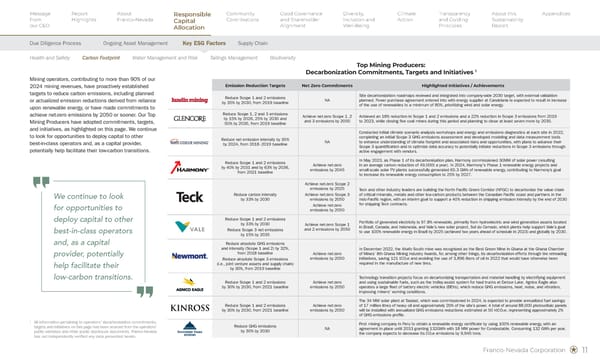Franco-Nevada Corporation 11 Mining operators, contributing to more than 90% of our 2024 mining revenues, have proactively established targets to reduce carbon emissions, including planned or actualized emission reductions derived from reliance upon renewable energy, or have made commitments to achieve net-zero emissions by 2050 or sooner. Our Top Mining Producers have adopted commitments, targets, and initiatives, as highlighted on this page. We continue to look for opportunities to deploy capital to other best-in-class operators and, as a capital provider, potentially help facilitate their low-carbon transitions. Top Mining Producers: Decarbonization Commitments, Targets and Initiatives 1 Emission Reduction Targets Net Zero Commitments Highlighted Initiatives / Achievements Reduce Scope 1 and 2 emissions by 35% by 2030, from 2019 baseline NA Site decarbonization roadmaps reviewed and integrated into company-wide 2030 target, with external validation planned. Power purchase agreement entered into with energy supplier at Candelaria is expected to result in increase of the use of renewables to a minimum of 80%, prioritizing wind and solar energy. Reduce Scope 1, 2 and 3 emissions by 15% by 2026, 25% by 2030 and 50% by 2035, from 2019 baseline Achieve net-zero Scope 1, 2 and 3 emissions by 2050 Achieved an 18% reduction in Scope 1 and 2 emissions and a 22% reduction in Scope 3 emissions from 2019 to 2023, while closing five coal mines during this period and planning to close at least seven more by 2035. Reduce net emission intensity by 35% by 2024, from 2018–2019 baseline NA Conducted initial climate scenario analysis workshops and energy and emissions diagnostics at each site in 2022, completing an initial Scope 3 GHG emissions assessment and developed modeling and data measurement tools to enhance understanding of climate footprint and associated risks and opportunities, with plans to advance their Scope 3 quantification and to optimize data accuracy to potentially initiate reductions in Scope 3 emissions through active engagement with vendors. Reduce Scope 1 and 2 emissions by 40% by 2031 and by 63% by 2036, from 2021 baseline Achieve net-zero emissions by 2045 In May 2023, as Phase 1 of its decarbonisation plan, Harmony commissioned 30MW of solar power (resulting in an average carbon reduction of 49,000t a year). In 2024, Harmony's Phase 1 renewable energy projects and small-scale solar PV plants successfully generated 65.3 GWh of renewable energy, contributing to Harmony’s goal to increase its renewable energy consumption to 25% by 2027. Reduce carbon intensity by 33% by 2030 Achieve net-zero Scope 2 emissions by 2025 Achieve net-zero Scope 3 emissions by 2050 Achieve net-zero emissions by 2050 Teck and other industry leaders are building the North Pacific Green Corridor (NPGC) to decarbonize the value chain of critical minerals, metals and other low-carbon products between the Canadian Pacific coast and partners in the Indo-Pacific region, with an interim goal to support a 40% reduction in shipping emission intensity by the end of 2030 for shipping Teck contracts. Reduce Scope 1 and 2 emissions by 33% by 2030 Reduce Scope 3 net emissions by 15% by 2035 Achieve net-zero Scope 1 and 2 emissions by 2050 Portfolio of generated electricity is 97.8% renewable, primarily from hydroelectric and wind generation assets located in Brazil, Canada, and Indonesia, and Vale’s new solar project, Sol do Cerrado, which plants help support Vale’s goal to use 100% renewable energy in Brazil by 2025 (achieved two years ahead of schedule in 2023) and globally by 2030. Reduce absolute GHG emissions and intensity (Scope 1 and 2) by 32%, from 2018 baseline Reduce absolute Scope 3 emissions (i.e., joint venture assets and supply chain) by 30%, from 2019 baseline Achieve net-zero emissions by 2050 In December 2022, the Ahafo South mine was recognized as the Best Green Mine in Ghana at the Ghana Chamber of Mines’ 8th Ghana Mining Industry Awards, for, among other things, its decarbonization efforts through tire retreading initiatives, saving 121 tCO2e and avoiding the use of 3,896 liters of oil in 2022 that would have otherwise been required in the manufacture of new tires. Reduce Scope 1 and 2 emissions by 30% by 2030, from 2021 baseline Achieve net-zero emissions by 2050 Technology transition projects focus on decarbonizing transportation and material handling by electrifying equipment and using sustainable fuels, such as the trolley-assist system for haul trucks at Detour Lake. Agnico Eagle also operates a large fleet of battery electric vehicles (BEVs), which reduce GHG emissions, heat, noise, and vibration, improving miners' working conditions. Reduce Scope 1 and 2 emissions by 30% by 2030, from 2021 baseline Achieve net-zero emissions by 2050 The 34 MW solar plant at Tasiast, which was commissioned in 2024, is expected to provide annualized fuel savings of 17 million litres of heavy oil and approximately 20% of the site’s power. A total of around 88,000 photovoltaic panels will be installed with annualized GHG emissions reductions estimated at 50 ktCO2e, representing approximately 2% of GHG emissions profile. Reduce GHG emissions by 30% by 2030 NA First mining company in Peru to obtain a renewable energy certificate by using 100% renewable energy, with an agreement in place until 2033 granting 132GWh with 18 MW power for Condestable. Consuming 132 GWh per year, the company expects to decrease its CO2e emissions by 9,945 tons. We continue to look for opportunities to deploy capital to other best-in-class operators and, as a capital provider, potentially help facilitate their low-carbon transitions. 1 All information pertaining to operators' decarbonization commitments, targets and initiatives on this page has been sourced from the operators' public websites and other public disclosure documents. Franco-Nevada has not independently verified any data presented herein. Responsible Capital Allocation Due Diligence Process Ongoing Asset Management Key ESG Factors Supply Chain Message from our CEO Report Highlights About Franco-Nevada Community Contributions Good Governance and Shareholder Alignment Diversity, Inclusion and Well-Being Transparency and Guiding Principles Climate Action About this Sustainability Report Appendices Health and Safety Carbon Footprint Water Management and Risk Tailings Management Biodiversity
 Sustainability Report 2025 Page 12 Page 14
Sustainability Report 2025 Page 12 Page 14